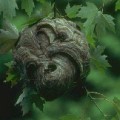It is said that infestations of Bed Bug are on the increase (some estimate as much as 5,000 percent). But don’t get the bleach out just yet. You are as likely to have picked them up in your suitcase while traveling as through unsanitary conditions.
Family Structure
- Eggs: white, about 1mm long
- Nymphs look like adults, but smaller
- Egg to adult: four weeks to several months, depending on temperature and food available (See the feeding chart to the right)
Appearance
- Flat, brown, wingless
- About 1/4 of an inch long
- 6 legs
- Shiny reddish-brown; appear dark brown and swollen after a feeding (see the picture below)
- Can be seen with the human eye but do a great job of hiding
- “True Bugs” –piercing mouthparts (usually feed on plants)
- Bed Bugs have adapted to feeding on human blood
Habitat
- Wherever people work or live – houses, apartments, hospitals, business offices
Bed Bugs love to hide. You could find them in:
- The seams of your mattress
- Seams in sofas and couches
- In small cracks in wooden furniture
- Underneath furniture
- Under throw rugs, carpeting, baseboards and casings
- Inside electrical fixtures
- Inside electronics, like the TV, stereo, and phone
- Backpacks, sleeping bags, clothes
- Behind wallpaper, picture frames and other dark areas
Diet
- Human blood
- Live up to a year without feeding
- Nymphs can survive several months without feeding
- Adult feeding: 10 to 15 minutes
- Nymphs: Less than 10 minutes
- Typically feed every three days.
Danger of Infection
Bed Bugs are not known to carry diseases as of yet. It is said that feeding on your blood will not cause you any harm; however, a Bed Bug that has just finished feeding can explode with just a little pressure, allowing you to come in contact with blood. If that blood is infected, you could run a risk of infection.
Scratching Bed Bug bites may lead to infection, too.
How do you know if you have Bed Bugs?
Finding bed bugs in your home has nothing to do with poor hygiene. It takes only one Bed Bug hitching a ride on your clothing (furniture, suitcase, etc.) to infest your entire residence.
Bites
Bed Bug bites are the best way to determine if you have Bed Bugs. In the photo below you’ll see a visitor who was bitten by Bed Bugs. He itched throughout the night; and when he went in to check, this is what he found!
Just a few simple precautions can prevent another occurrence of this problem. Study this information to help determine if you have Bed Bugs, how to deal with infestations, pictures of Bed Bug bites (from people around the world) and – most important – how to protect yourself during travel!
The image to your left is a severe reaction, and you may find that your bites are not this bad. Not everyone reacts the same way. If you have such a reaction, check with your doctor, who may recommend an antihistamine or topical cream to relieve itching and/or burning.
Mold-Like Spots
Another sign of Bed Bugs is mold-like spots on your mattress. If you question whether you have them, check your mattress.
What do you do if you suspect an infestation?
If you suspect you have an infestation, contact a licensed exterminator.
Contact Us
Contact us for help with a Bed Bug problem. You may also call either our Central Coast office or our Ventura County office.






